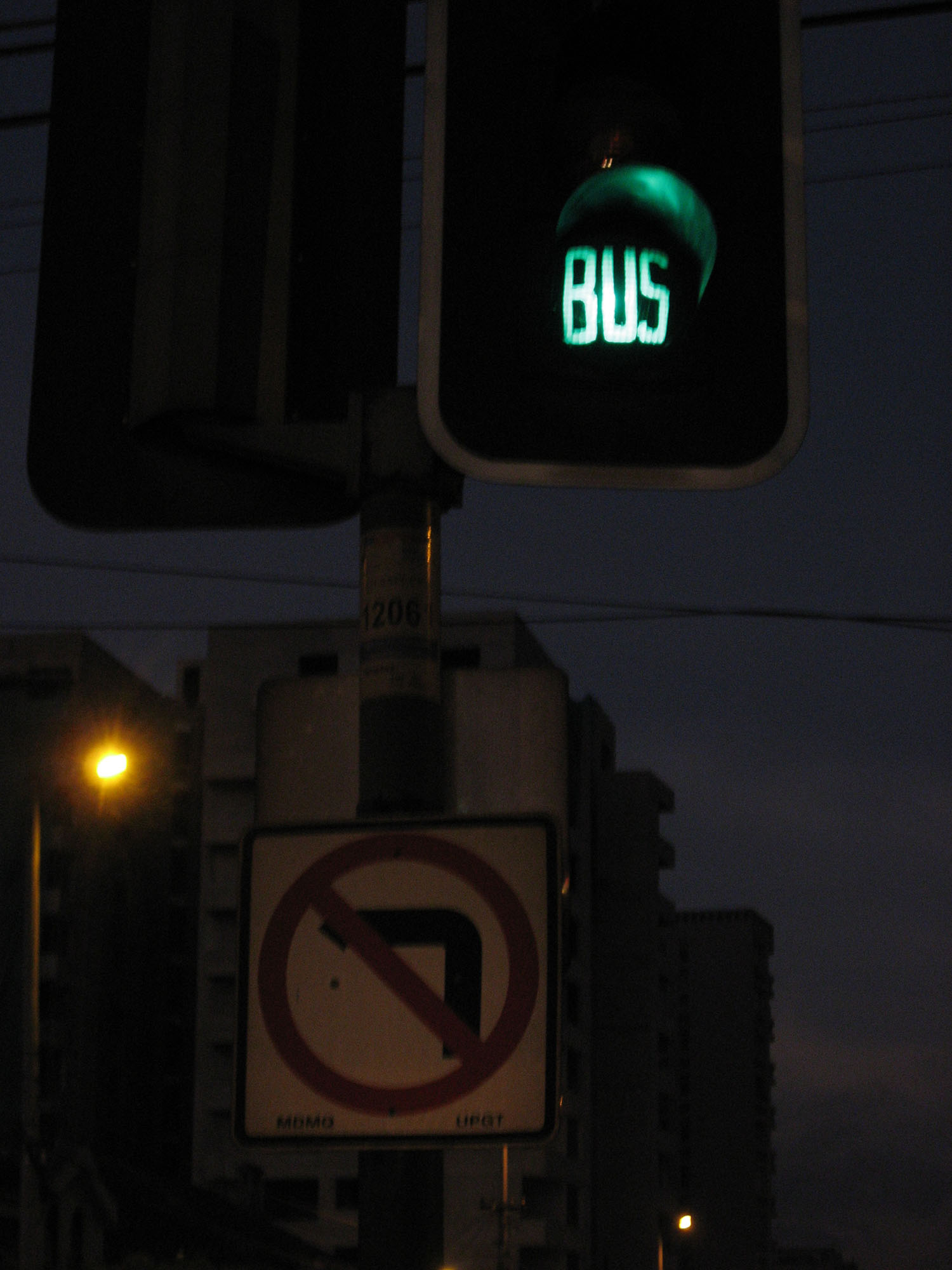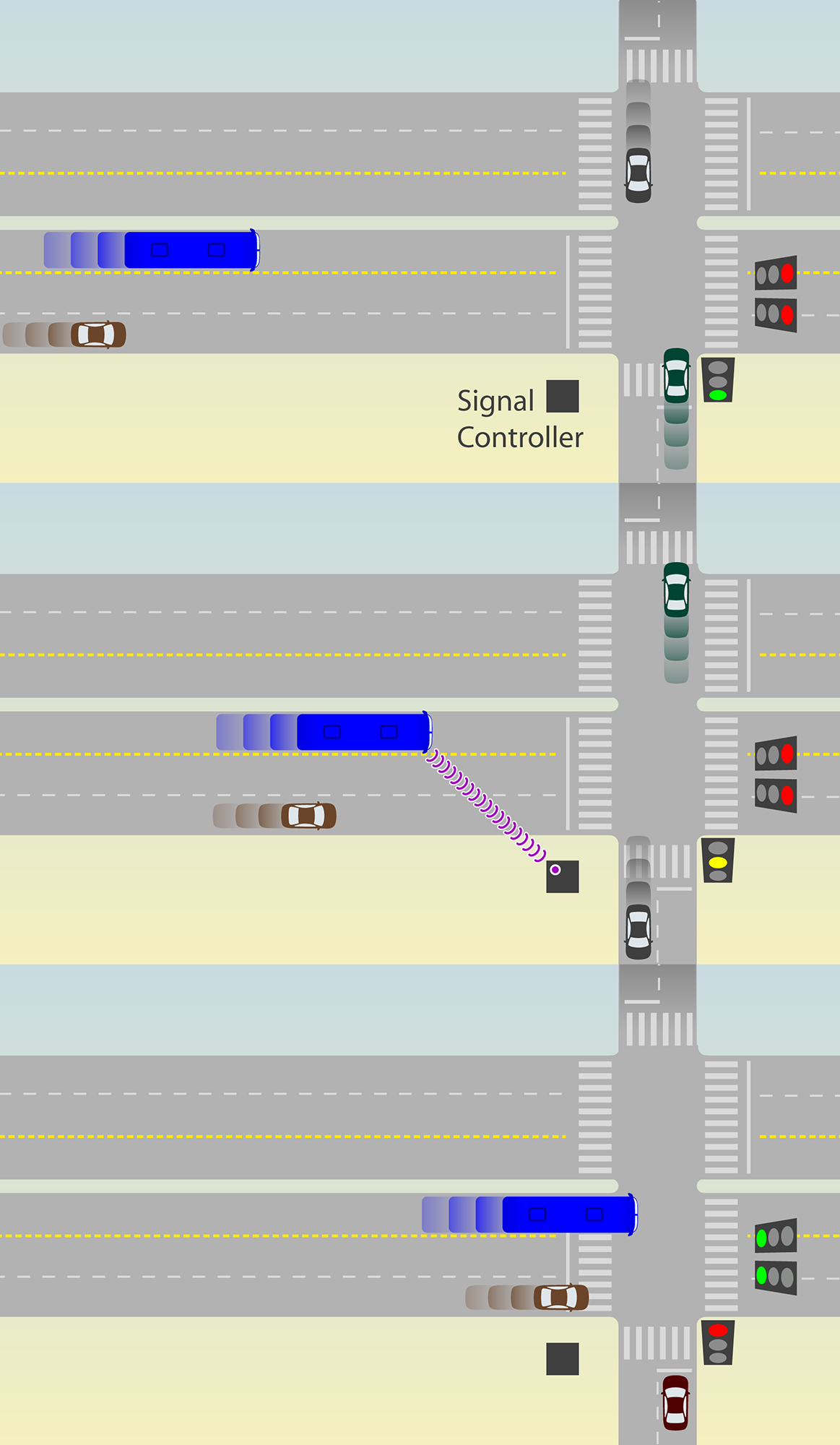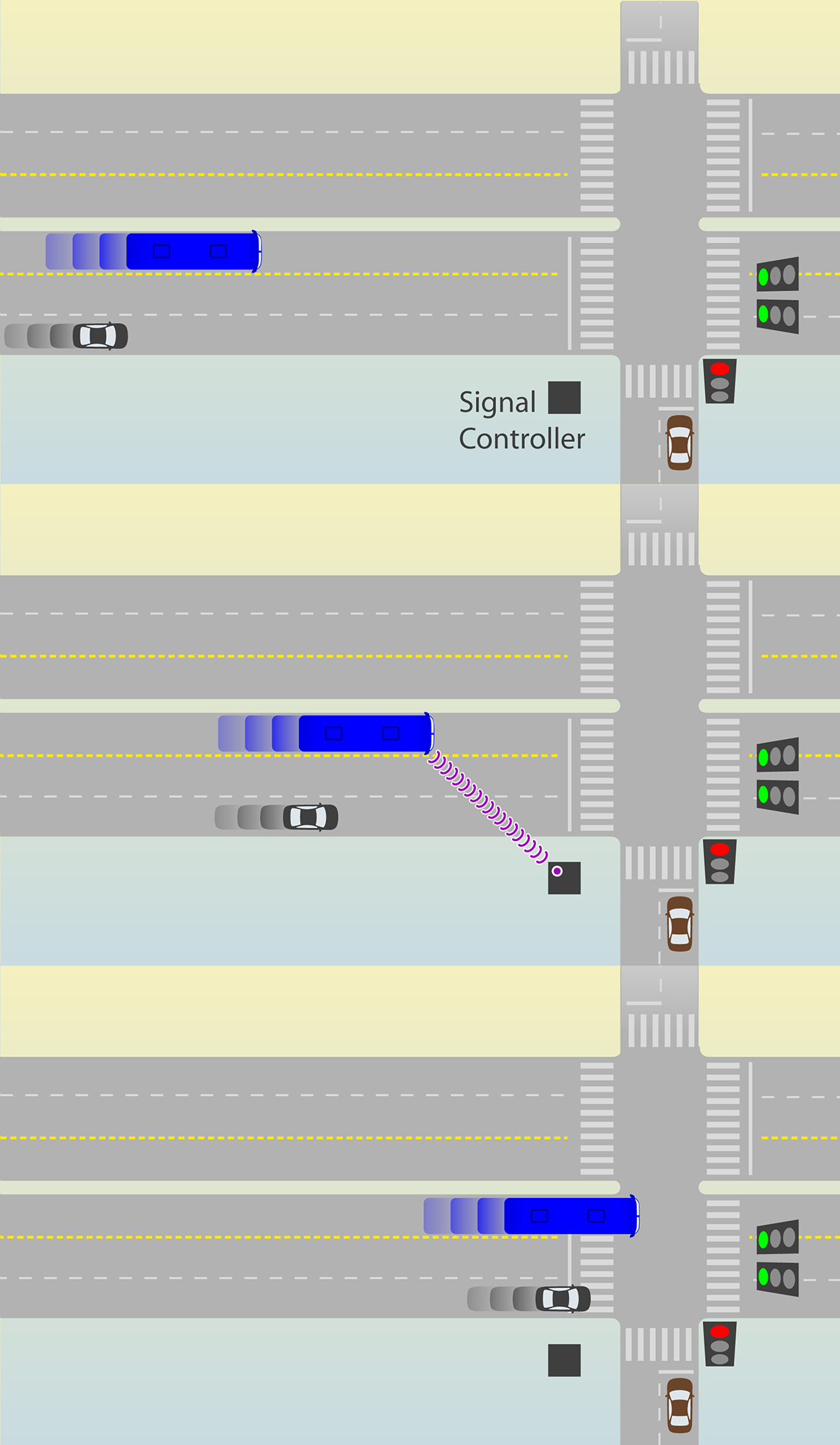24.3Traffic Signal Priority
On a traffic light green means go and yellow means yield, but on a banana it’s just the opposite. Green means hold on, yellow means go ahead, and red means where the hell did you get that banana.Mitch Hedberg, comedian, 1968–2005

Signal priority for BRT vehicles is the adjustment of traffic signals to give priority to a corridor with a BRT system over a corridor without one, and to give priority to the BRT system over mixed traffic within the same corridor. Once equipment and techniques were developed to do this in a responsive way after the detection of BRT vehicles approaching an intersection, the expression “active signal priority” became the way to indicate this advance. Since then “passive signal priority” is used to indicate that such detection technology is not being applied.
24.3.1Passive Signal Priority
Together with signal phase simplification, passive signal priority is crucial to proper BRT intersection design. The two techniques are complementary and must be considered jointly for implementation.
Prioritization is primarily achieved by extending the relative green time for the BRT corridor over the crossing streets that do not have public transport. This action reduces the travel time of the entire traffic stream (both BRT and mixed-traffic) on the corridor at the expense of the travel time of the crossing traffic stream.
Without special consideration for BRT, the optimal phase time in a signalized intersection is such that the cycle time is as brief as possible without growing queues. At the highest extreme, this guideline would change to give as much green time as possible to the BRT corridor without resulting queues. The longest green signal phase would depend on the flow of mixed traffic on the crossing street. The ideal way to balance the traffic light, however, is to consider the average wait time by each flow, including pedestrians multiplied by the number of people in each flow.
In applying traffic signal priority to a BRT corridor, it is typical that cycle time becomes as low as 60 seconds and does not rise above 120 seconds except at major intersections or during peak hours in order to allow larger relative green time for the BRT corridor. The relative green time faced by the BRT system should be extended above 50 percent, if possible. It is typical for the BRT green time to be 30 seconds in a 60-second cycle or 40 to 60 seconds in a 120-second cycle.
Synchronization of green signal phases between intersections (or “green wave,” see coordination as discussed in Section 24.1.3: Traffic Signal Concepts) is not common with BRT systems because BRT travel times are not regularly subject to variable dwell time at stations (especially when multiple route services use the same corridor or frequencies are high). If BRT vehicle speeds are reasonably predictable or controlled, then it is possible to coordinate traffic lights in a BRT corridor. This practice is used in Ottawa, Ontario, Canada (Levinson et al., 2003b). If boarding and alighting times are somewhat regular and of the same magnitude of the green time of the green wave planned for mixed traffic, coordination will lead to the opposite effect, as every time the BRT vehicles dwell in a station they are likely to reach the next traffic light at the beginning of the red light.
24.3.2Active Signal Priority
Active, or real-time priority techniques, change the actual traffic signal phasing when a BRT vehicle is observed to be approaching the intersection.
The normal vehicle identification mechanism is to have a transponder detect the BRT vehicle prior to its arrival at the stop line. If the BRT vehicle is detected during the green phase, and the green phase is nearing the yellow phase, then the green phase is extended. If the detection occurs during the red or the yellow interval, the green time is recalled more quickly than normal. Some general guidelines for applying phase extension or phase shortening include:
- The minimum side street green time is set based on the amount of time pedestrians need to cross the road;
- The amount of green signal extension or advance should be up to a specific, set maximum;
- The BRT corridor green is not generally both advanced and extended in the same cycle.
The green times are likely to be most easily extended at intersections with light cross traffic.


The importance of active traffic signal priority on BRT vehicle speeds tends to be greatest in systems with fairly low bus volumes, particularly with bus headways longer than five minutes where intersections are frequent and might be a relevant measure for increasing system speeds. In such instances, signal priority may reduce signal delay by between 10 and 20 percent. In this context, it is often easier to give buses signal priority at intersections without major disruption to mixed-traffic flows.
When BRT vehicle headways are less than 2.5 minutes, it is generally difficult to implement active signal priority at all: the non-BRT traffic direction would essentially be in a state of a permanent red phase. However, even with BRT vehicles at high frequencies, giving active priority to the BRT running on less important cross streets can yield benefits of between 4 to 10 percent of the delay in traffic signals. While this savings is not as significant as some other priority measures such as restricting mixed-traffic turns, it can be a justifiable expenditure contributing to efficiency gains as vehicle detection, signaling equipment, and priority software become more common, and their costs increasingly affordable.
At an even higher level of sophistication, the priority phasing can be based on observed traffic levels for both the BRT vehicles and the general traffic. A special weighting can be given to BRT vehicles or to the BRT corridor. In traffic systems where flows are quite irregular, real-time control that adjusts signal times to observed traffic levels can yield benefits. In such real-time systems, phase changing is usually based on a trade-off between the benefits and costs faced by the green and red approaches and for the general principle of shortening red times; a fully actuated system based on total vehicle movements, which also includes BRT vehicles, is probably more important than BRT-specific detection. The application of signal priority, both passive and active, is looked at further in Section 24.7: Merging with Mixed Traffic in Narrow Sections and Section 24.8: BRT Lanes at Roundabouts.